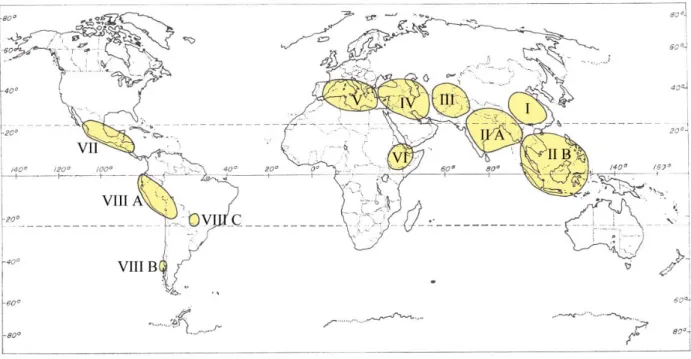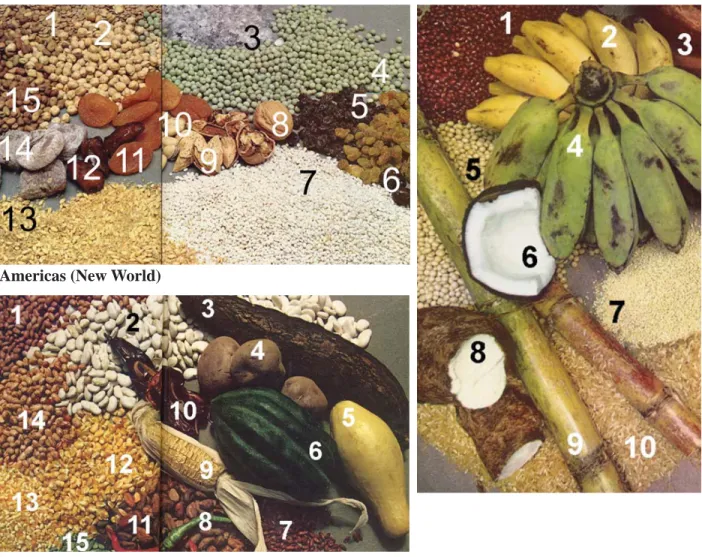Lecture 5
Centers of Origin of Crop Plants
Fig. 5-1. The eight Vavilovian centers of origin for crop plants The Eight Vavilovian Centers (Fig. 5-1, 5-2)
Old World
I. Chinese Center: The largest independent center which includes the mountainous regions of central and western China, and adjacent lowlands. A total of 136 endemic plants are listed, among which are a few known to us as important crops.
Cereals and Legumes
1. Broomcorn millet, Panicum miliaceum 2. Italian millet, Panicum italicum
3. Japanese barnyard millet, Panicum frumentaceum 4. Kaoliang, Andropogon sorghum
5. Buckwheat, Fagopyrum esculentum 6. Hull-less barley, Hordeum hexastichum 7. Soybean, Glycine max
8. Adzuki bean, Phaseolus angularis 9. Velvet bean, Stizolobium hassjoo
The origin of crop plants is now basic to plant breeding in order to locate wild relatives, related species, and new genes (especially dominant genes, sources of disease resistance).
Knowledge of the origins of crop plants is vitally important in order to avoid genetic erosion, the loss of germplasm due to the loss of ecotypes and landraces, loss of habitat (such as rainforests), and increased urbanization. Germplasm preservation is accomplished through gene banks (largely seed collections but now frozen stem sections) and preservation of natural habitats (especially in centers of origin).
Near East Far East
Americas (New World)
Near East 1. Lentil 2. Chickpea 3. Salt 4. Pea 5. Raisin 6. Olive 7. Barley 8. Walnut 9. Almond 10. Pistachio nut 11. Apricot 12. Date 13. Wheat 14. Fig 15. Fava bean
Fig. 5-2. Origin of basic crops. Source: J.N. Leonard 1973, First Farmers. Americas 1. Pink bean 2. Lima bean 3. Manioc 4. Potato 5. Summer squash 6. Acorn squash
7. Small dried chili pepper 8. Fresh chili pepper 9. Corn (maize) 10. Dried chili pepper 11. Cocoa bean 12. Whole dried corn 13. Cracked dried corn 14. Pinto bean
15. Shelled pumpkin seed
Far East 1. Adsuki bean 2. Yellow banana 3. Red banana 4. Green banana 5. Soybean 6. Coconut 7. Millet 8. Yam 9. Sugar cane 10. Rice
Roots, Tubers, and Vegetables
1. Chinese yam, Dioscorea batatas 2. Radish, Raphanus sativus
3. Chinese cabbage, Brassica chinensis, B. pekinensis 4. Onion, Allium chinense, A. fi stulosum, A. pekinense 5. Cucumber, Cucumis sativus
Fruits and Nuts
1. Pear, Pyrus serotina, P. ussuriensis 2. Chinese apple, Malus asiatica 3. Peach, Prunus persica
4. Apricot, Prunus armeniaca 5. Cherry, Prunus pseudocerasus 6. Walnut, Juglans sinensis
7. Litchi, Litchi chinensis Sugar, Drug, and Fiber Plants
1. Sugarcane, Saccharum sinense 2. Opium poppy, Papaver somniferum 3. Ginseng, Panax ginseng
4. Camphor, Cinnamomum camphora 5. Hemp, Cannabis sativa
II. Indian Center: This area has two subcenters.
A. Main Center (Hindustan): Includes Assam and Burma, but not Northwest India, Punjab, nor Northwest Frontier Provinces. In this area, 117 plants were considered to be endemic.
Cereals and Legumes
1. Rice, Oryza sativa
2. Chickpea or gram, Cicer arietinum 3. Pigeon pea, Cajanus indicus 4. Urd bean, Phaseolus mungo 5. Mung bean, Phaseolus aureus 6. Rice bean, Phaseolus calcaratus 7. Cowpea, Vigna sinensis
Vegetables and Tubers
1. Eggplant, Solanum melongena 2. Cucumber, Cucumis sativus
3. Radish, Raphanus caudatus (pods eaten) 4. Taro, Colocasia antiquorum
5. Yam, Dioscorea alata
Fruits
1. Mango, Mangifera indica 2. Orange, Citrus sinensis
3. Tangerine, Citrus nobilis 4. Citron, Citrus medica
Sugar, Oil, and Fiber Plants
1. Sugar cane, Saccharum offi cinarum 2. Coconut palm, Cocos nucifera 3. Sesame, Sesamum indicum 4. Saffl ower, Carthamus tinctorius 5. Tree cotton, Gossypium arboreum 6. Oriental cotton, Gossypium nanking 7. Jute, Corchorus capsularis
8. Crotalaria, Crotalaria juncea 9. Kenaf, Hibiscus cannabinus Spices, Stimulants, Dyes, and Miscellaneous
1. Hemp, Cannabis indica 2. Black pepper, Piper nigrum 3. Gum arabic, Acacia arabica 4. Sandalwood, Santalum album 5. Indigo, Indigofera tinctoria
6. Cinnamon tree, Cinnamomum zeylanticum 7. Croton, Croton tiglium
8. Bamboo, Bambusa tulda
B. Indo-Malayan Center: Includes Indo-China and the Malay Archipelago. Fifty-fi ve plants were listed, including:
Cereals and Legumes
1. Job’s tears, Coix lacryma 2. Velvet bean, Mucuna utilis Fruits
1. Pummelo, Citrus grandis
2. Banana, Musa cavendishii, M. paradisiaca, H. sapientum 3. Breadfruit, Artocarpus communis
4. Mangosteen, Garcinia mangostana Oil, Sugar, Spice, and Fiber Plants
1. Candlenut, Aleurites moluccana 2. Coconut palm, Cocos nucifera 3. Sugarcane, Saccharum offi cinarum 4. Clove, Caryophyllus aromaticus 5. Nutmeg, Myristaca fragrans 6. Black pepper, Piper nigrum
7. Manila hemp or abaca, Musa textilis
III. Central Asiatic Center: Includes Northwest India (Punjab, Northwest Frontier Provinces and Kashmir), Afghanistan, Tadjikistan, Uzbekistan, and western Tian-Shan. Forty-three plants are listed for this center, including many wheats.
Grains and Legumes
1. Common wheat, Triticum vulgare 2. Club wheat, Triticum compactum
3. Shot wheat, Triticum sphaerocoecum 4. Pea, Pisum sativum
5. Lentil, Lens esculenta 6. Horse bean, Vicia faba 7. Chickpea, Cicer arientinum 8. Mung bean, Phaseolus aureus 9. Mustard, Brassica juncea
10. Flax, Linum usitatissimum (one of the centers) 11. Sesame, Sesamum indicum
Fiber Plants
1. Hemp, Cannabis indica 2. Cotton, Gossypium herbaceum Vegetables
1. Onion, Allium cepa 2. Garlic, Allium sativum 3. Spinach, Spinacia oleracea 4. Carrot, Daucus carota Fruits
1. Pistacia, Pistacia vera 2. Pear, Pyrus communis
3. Almond, Amygdalus communis 4. Grape, Vitis vinifera
5. Apple, Malus pumila
IV. Near-Eastern Center: Includes interior of Asia Minor, all of Transcaucasia, Iran, and the highlands of Turkmenistan. Eighty-three species including nine species of wheat were located in this region.
Grains and Legumes
1. Einkorn wheat, Triticum monococcum (14 chromosomes) 2. Durum wheat, Triticum durum (28 chromosomes)
3. Poulard wheat, Triticum turgidum (28 chromosomes) 4. Common wheat, Triticum vulgare (42 chromosomes) 5. Oriental wheat, Triticum orientale
6. Persian wheat, Triticum persicum (28 chromosomes) 7. Triticum timopheevi (28 chromosomes)
8. Triticum macha (42 chromosomes)
9. Triticum vavilovianum, branched (42 chromosomes) 10. Two-row barleys, Hordeum distichum, H. nutans 11. Rye, Secale cereale
12. Mediterranean oats, Avena byzantina 13. Common oats, Avena sativa
14. Lentil, Lens esculenta
Forage Plants
1. Alfalfa, Medicago sativa
2. Persian clover, Trifolium resupinatum 3. Fenugreek, Trigonella foenum graecum
4. Vetch, Vicia sativa
5. Hairy vetch, Vicia villosa Fruits
1. Fig, Ficus carica
2. Pomegranate, Punica granatum
3. Apple, Malus pumilo (one of the centers) 4. Pear, Pyrus communis and others
5. Quince, Cydonia oblonga 6. Cherry, Prunus cerasus 7. Hawthorn, Crataegus azarolus
V. Mediterranean Center: Includes the borders of the Mediterranean Sea. Eighty-four plants are listed for this region including olive and many cultivated vegetables and forages.
Cereals and Legumes
1. Durum wheat, Triticum durum expansum 2. Emmer, Triticum dicoccum (one of the centers) 3. Polish wheat, Triticum polonicum
4. Spelt, Triticum spelta
5. Mediterranean oats, Avena byzantina 6. Sand oats, Avena brevis
7. Canarygrass, Phalaris canariensis 8. Grass pea, Lathyrus sativus
9. Pea, Pisum sativum (large seeded varieties) 10. Lupine, Lupinus albus, and others
Forage Plants
1. Egyptian clover, Trifolium alexandrinum 2. White Clover, Trifolium repens
3. Crimson clover, Trifolium incarnatum 4. Serradella, Ornithopus sativus
Oil and Fiber Plants
1. Flax, Linum usitatissimum, and wild L. angustifolium 2. Rape, Brassica napus
3. Black mustard, Brassica nigra 4. Olive, Olea europaea
Vegetables
1. Garden beet, Beta vulgaris 2. Cabbage, Brassica oleracea
3. Turnip, Brassica campestris, B. napus 4. Lettuce, Lactuca sativa
6. Celery, Apium graveolens 7. Chicory, Cichorium intybus 8. Parsnip, Pastinaca sativa 9. Rhubarb, Rheum offi cinale Ethereal Oil and Spice Plants
1. Caraway, Carum carvi 2. Anise, Pimpinella anisum 3. Thyme, Thymus vulgaris
4. Peppermint, Mentha piperita 5. Sage, Salvia offi cinalis 6. Hop, Humulus lupulus
VI. Abyssinian Center: Includes Abyssinia, Eritrea, and part of Somaliland. In this center were listed 38 species. Rich in wheat and barley.
Grains and Legumes
1. Abyssinian hard wheat, Triticum durum abyssinicum 2. Poulard wheat, Triticum turgidum abyssinicum 3. Emmer, Triticum dicoccum abyssinicum 4. Polish wheat, Triticum polonicum abyssinicum 5. Barley, Hordeum sativum (great diversity of forms) 6. Grain sorghum, Andropogon sorghum
7. Pearl millet, Pennisetum spicatum 8. African millet, Eleusine coracana 9. Cowpea, Vigna sinensis
10. Flax, Linum usitatissimum Miscellaneous
1. Sesame, Sesamum indicum (basic center) 2. Castor bean, Ricinus communis (a center) 3. Garden cress, Lepidium sativum
4. Coffee, Coffea arabica 5. Okra, Hibiscus esculentus 6. Myrrh, Commiphora abyssinicia 7. Indigo, Indigofera argente
New World
VII. South Mexican and Central American Central: Includes southern sections of Mexico, Guatemala, Honduras and Costa Rica.
Grains and Legumes
1. Maize, Zea mays
2. Common bean, Phaseolus vulgaris 3. Lima bean, Phaseolus lunatus 4. Tepary bean, Phaseolus acutifolius 5. Jack bean, Canavalia ensiformis
Melon Plants
1. Malabar gourd, Cucurbita fi cifolia 2. Winter pumpkin, Cucurbita moshata 3. Chayote, Sechium edule
Fiber Plants
1. Upland cotton, Gossypium hirsutum 2. Bourbon cotton, Gossypium purpurascens 3. Chayote, Sechium edule
Miscellaneous
1. Sweetpotato, Ipomea batatas 2. Arrowroot, Maranta arundinacea
3. Pepper, Capsicum annuum, C. frutescens 4. Papaya, Carica papaya
5. Guava, Psidium guayava
6. Cashew, Anacardium occidentale 7. Wild black cherry, Prunus serotina 8. Cochenial, Nopalea coccinellifera
9. Cherry tomato, Lycopersicum cerasiforme 10. Cacao, Theobroma cacao
11. Nicotiana rustica
VIII. South American Center: (62 plants listed) Three subcenters are found.
A. Peruvian, Ecuadorean, Bolivian Center: Comprised mainly of the high mountainous areas, formerly the center of the Megalithic or Pre-Inca civilization. Endemic plants of the Puna and Sierra high elevation districts included:
Root Tubers
1. Andean potato, Solanum andigenum (96 chromosomes)
2. Other endemic cultivated potato species. Fourteen or more species with chromosome numbers varying from 24 to 60.
3. Edible nasturtium, Tropaeolum tuberosum. Coastal regions of Peru and non-irrigated subtropical and tropical regions of Ecuador, Peru and Bolivia included:
Grains and Legumes
1. Starchy maize, Zea mays amylacea
2. Lima bean, Phaseolus lunatus (secondary center) 3. Common bean, Phaseolus vulgaris (secondary center)
Root Tubers
1. Edible canna, Canna edulis
2. Potato, Solanum phureja (24 chromosomes) Vegetable Crops
1. Pepino, Solanum muricatum 2. Tomato, Lycopersicum esculentum
3. Ground cherry, Physalis peruviana 4. Pumpkin, Cucurbita maxima 5. Pepper, Capsicum frutescens Fiber Plants
1. Egyptian cotton, Gossypium barbadense Fruit and Miscellaneous
1. Passion fl ower, Passifl ora ligularis 2. Guava, Psidium guajava
3. Heilborn, Carica candamarcensis 4. Quinine tree, Cinchona calisaya 5. Tobacco, Nicotiana tabacum B. Chiloe Center (Island near the coast of southern Chile)
1. Common potato, Solanum tubersum (48 chromosomes) 2. Wild strawberry, Fragaria chiloensis
C. Brazilian-Paraguayan Center
1. Manioc, Manihot utilissima 2. Peanut, Arachis hypogaea 3. Rubber tree, Hevea brasiliensis 4. Pineapple, Ananas comosa 5. Brazil nut, Bertholletia excelsa 6. Cashew, Anacardium occidentale 7. Purple granadilla, Passifl ora edulis

